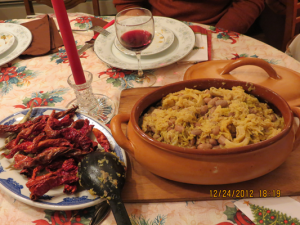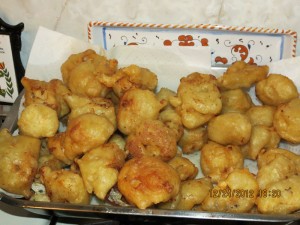Abruzzese Christmas in New York
I was fortunate as a child to experience many old world traditions from Abruzzo. My family arrived later to the United States than most Italian Americans. My father came here in 1956 and my mother followed him in 1958. My sisters and I were born in New York. However, our home was a step back into time, a time of simplicity and of old world Abruzzo. For one thing, my father built a fireplace in the kitchen which was really unheard of in modern homes in the US, let alone the City of New York. We had a large farmhouse kitchen reminiscent of “le masserie” in Italy.
Our Christmas, like everyone else’s holiday was special. But ours was a little bit more special, maybe more unique. My family is from Orsogna, a small town in the Abruzzo region nestled atop a cliff overlooking the Moro Valley onto the Majella Mountain. Abruzzo is a remote area of Italy protected by mountains and has maintained its traditions and culture a bit more than other regions in Italy due to its geographic nature.
Our Christmas season would begin with the feast of San Nicola (December 6). San Nicola was originally patron saint of our town many years ago and the mother church in Orsogna is La Chiesa di San Nicola. My grandfather’s name was Nicola and it was also his birthday, therefore, it was the beginning of our festivities.
The following day, December 7th, was the eve of the Immaculate Conception. That day was reserved for a small dinner of cabbage and sardines. The following day, the Immaculate Conception was a day of rich sauce which included gnocchi and a roast. The vino cotto was taken out for the first time. It was also my grandmother and sister’s onomastico.
Between the feast of the Immaculate Conception and Christmas Eve, we would gather together as a family and make le crispelle or as we called them “le cose fritte”. They are fired potato dough in the formation of long batons. That evening would be a big family gathering with opening of the new wine that was made this past season and roasting chestnuts and chickpeas on the potbelly stove in the garage. It was an informal evening but everyone would be over at the house.
During this time, as a child, my family would play records of the zampognari, the bagpipers that Abruzzo is so famous for. The house would be filled with this magical music. The songs that the bagpipers played were the playlist that embodied our culture, our traditional/folkloric heritage. It wasthe life that we longed for and held on so dearly. In Abruzzo, the zampognari would travel from home to home, playing eating and bringing Christmas joy to everyone in town. Some 20 years ago, in some Abruzzesi communities in New York, the zampognari would travel from home to home entertaining their paesani.
Christmas light adorned the outside of the house, making our house the brightest in the neighborhood. The more lights my father added, the more devotion to the feast.
This was also a time of preparing for the feast. The cardone would be bought, chopped, boiled and prepared for the Christmas soup. Pizza rustica was also made and prepared for the soup. Pizzelle, using the old iron skillet were made in the hundreds and hidden from the children. We would also make taralli. Our famous cookie stuffed with marmalade made from crushed grapes from the wine that was just made during the fall. The marmalade was mixed with chocolate, orange peels and walnuts. My mother would make it from scratch and the smell would permeated all our senses and that’s how we knew Christmas was in the air. We also made another form of taralli called “cavacioni” made from chick peas and chocolate filling.
On the tree, which was always fresh, my mother would hang little boxes of torrone for us. We would also have stocking stuffed with walnuts and mandarins. The small presepio from Italy would be placed under the tree. Also at that time, we would always try to make phone calls to Italy but only if we could get a line through. The mail would come twice a day with hundreds of Christmas cards that we would hang across the fireplace.
Christmas Eve dinner was very different from the other Italian American Christmas eves. In the ancient Christian tradition, there is usually fasting on the eve of a feast. In our tradition, we did not exactly feast as others did. Our feast was a pauper’s feast. It was not rich as many other Italian Americans had who originated from other regions. Our feast was made up of cabbage and beanswhich included fried sardines and fried dried peppers. We also did have fish for our dinner. We made fried baccala. We did include pasta with tuna tomato sauce but we did not serve fish that was rich or expensive like “capitone” or crustaceous fish. Christmas Eve represented the reflection of the eve, a sense of preparation for the birth of Christ which was the following day. Always reflecting in humility of the eve of the event.
The evening dinner continued with a game of tombola or cards, depending on the participation of the children.
Chestnuts were roasted, the fennel and mandarins were taken out and we waited to prepare to leave for midnight mass. In the meantime, relatives and guests were arriving one after another to visit.
The following morning was Christmas. In the morning, we would begin to smell the ragu` simmering. The famous holiday soup “il Brodo” with cardone as already up on the stove and cooking. The pizza rustica for the soup had been made days earlier and was cut in cubes. Spaghetti alla chittarra was served followed by a roasted capon and roast pork with potatoes. We would also serve roasted rabbit with potatoes made “sotto lu coppa” (under a bronze lid) cooked in the fireplace under mounds of coal.
After that the large meal, the famous panettone would be served with the taralli, pizzelle, crispelle e cavacioni. Liqueurs that were saved for the holiday was served along with torrone and other sweet delights.
Again, as the night before, tombola was played until the late hours while Italian Christmas music was played along with the traditional Abruzzese folk music.
The following day was San Stefano. It was also the night that we went visiting other relatives to continue the festivities. It was a day of eating left overs and another evening of playing tombola.
Our Abruzzese Christmas was not just a day of eating or indulgences, but it was a period of time when we reflected on what was important in life, our families, tradition, culture, religion. We renewed our commitment to each other and enriched our daily lives with reminders of our roots and ancestral heritage. It was that one time of year when we stepped back from our adopted American life to replenish our souls with our own traditionsand customs.







